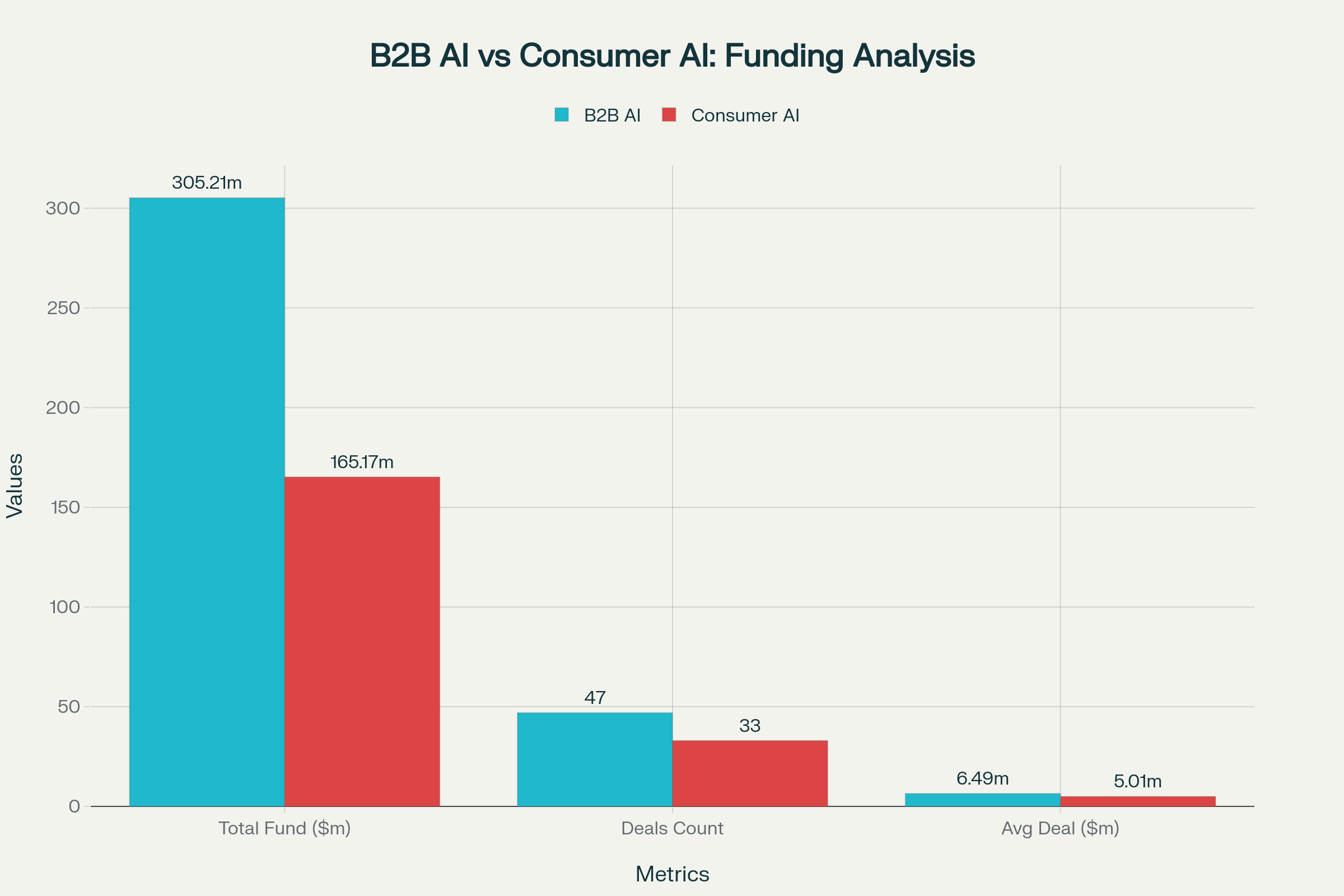Executive Summary
The artificial intelligence investment landscape has reached a critical inflection point. Despite venture capitalists pouring over $200 billion globally into AI initiatives, a fundamental capital misallocation crisis is undermining the entire ecosystem's potential. While B2B AI companies capture 64.9% of total funding—nearly twice that of consumer AI—they deliver catastrophically poor results, with 95% of enterprise AI pilots failing to generate measurable returns.
This paradox reveals a deeper structural problem: the AI investment community is systematically directing capital toward the wrong solutions, creating a dangerous feedback loop that enriches vendors while starving genuine innovation. Our analysis exposes how this $200 billion misallocation threatens to derail AI's transformative potential and what investors must do to correct course.
The Numbers Don't Lie: B2B AI's Expensive Failure
The stark reality of AI investment allocation reveals a market fundamentally disconnected from performance outcomes:

2023-2025 AI Funding Breakdown
- B2B AI: $305.2 million (64.9% of total funding)
- Consumer AI: $165.2 million (35.1% of total funding)
- Average B2B deal size: $6.5 million
- Average consumer deal size: $5.0 million
The Performance Gap
- B2B AI success rate: 5% (95% failure rate per MIT study)
- Consumer AI success rate: 67% when purchasing specialized solutions
- Enterprise AI ROI: 5.9% against 10% capital cost (IBM data)
- Consumer AI adoption: Immediate feedback and natural selection
This data exposes a fundamental market failure: investors are systematically overvaluing and overfunding the segment with the worst performance metrics while underinvesting in the segment with proven success patterns.
The Funding Trajectory: Doubling Down on Failure
Year-over-year funding trends reveal that investors are not learning from failure patterns but instead amplifying them:
2023-2025 Investment Evolution
- 2023: B2B AI ($68.7M) vs Consumer AI ($95.4M)
- 2024: B2B AI ($100.1M) vs Consumer AI ($121.8M)
- 2025: B2B AI ($136.4M) vs Consumer AI ($12.9M)
The dramatic shift represents a 956% increase in B2B AI funding while consumer AI investment collapsed by 89%. This trend indicates that investors are doubling down on enterprise applications despite mounting evidence of systematic implementation failures.
Round Distribution: Where Capital Concentrates
The concentration of AI funding across investment stages reveals another dimension of the misallocation problem:
Capital Distribution by Stage
- Series A: 25% of total AI funding
- Seed: 23% of total funding
- Series B: 21% of total funding
- Later stages: Remaining 31%
This distribution suggests that investors are backing more mature companies with proven traction, yet the high enterprise failure rates indicate that even well-funded, later-stage AI companies struggle with fundamental execution challenges that money alone cannot solve.
Investor Voices: Growing Recognition of the Problem
Leading venture capitalists are beginning to acknowledge the systematic problems plaguing B2B AI investments, though their capital allocation hasn't yet caught up with their insights.
Ed Sim, Boldstart Ventures: The Differentiation Crisis
"The first common mistake is there's zero differentiation for what you're building. You're just an AI wrapper and you literally are just offering something that a lot of the big companies can offer."
Sim's observation highlights a fundamental issue: most B2B AI companies are building undifferentiated solutions that incumbent technology providers can easily replicate, making their venture capital premium unjustifiable.
Jenny Fielding, Everywhere Ventures: The Business Model Problem
"AI is an enabling technology—it's not the business itself. We don't invest in 'AI-first' companies. Instead, we back startups solving meaningful problems in healthcare, fintech, climate, and other industries—whether or not they use AI."
Fielding's perspective represents a minority view that focuses on business fundamentals rather than technology hype, yet her fund's approach aligns more closely with actual success patterns.
Brian Hollins, Collide Capital: The Crowding-Out Effect
"Don't build an AI business just because it's hot. Build something that stands out in a crowded space."
Hollins warns against trend-following that has created an oversaturated market of similar B2B AI solutions competing primarily on venture capital funding rather than customer value creation.
The Consumer AI Advantage: Why Simpler Succeeds
Consumer AI's superior success rate stems from structural advantages that enterprise AI systematically lacks:
Inherent Advantages of Consumer AI
Immediate Value Assessment: Individual users can instantly determine whether an AI tool provides value, creating natural selection pressure that enterprise procurement processes lack.
Minimal Integration Complexity: Consumer applications don't require integration with legacy enterprise systems, eliminating the technical barriers that doom 87% of enterprise AI projects.
Rapid Iteration Cycles: Consumer products can evolve quickly based on user feedback, while enterprise AI often requires lengthy approval processes for any modifications.
Lower Implementation Costs: Consumer AI typically requires minimal technical infrastructure compared to enterprise deployments that demand extensive customization and change management.
Direct Payment Models: Consumers pay directly for value received, while enterprise AI often involves complex procurement processes that disconnect usage from payment.
The $200 Billion Misallocation: Systematic Failure Patterns
The scale of capital misallocation becomes clear when examining specific enterprise AI failure patterns that investors continue to fund despite consistent poor outcomes:
The Integration Nightmare
Enterprise AI must navigate data governance requirements that can delay projects by 3-6 months, while consumer AI faces no such barriers. Yet investors continue to fund enterprise solutions that systematically underestimate integration complexity.
The Organizational Resistance Problem
52% of workers express concern about AI, creating adoption challenges that directly impact ROI realization. Consumer AI bypasses this resistance by targeting individual rather than organizational adoption.
The Procurement Friction Factor
Enterprise sales cycles are lengthy and complex, often taking 12-18 months to complete, while consumer AI achieves immediate adoption and generates usage feedback within days.
The Legacy System Trap
B2B AI must work with existing business systems built over decades, often requiring expensive custom development that consumer applications avoid entirely.
Corporate Recognition of the Problem
Even major corporations are acknowledging the systematic challenges facing enterprise AI investments:
Microsoft's Long-Term Perspective
Microsoft CFO Amy Hood's acknowledgment of 15-year payback periods for AI investments reveals the challenging economics facing even the most sophisticated enterprise AI implementations.
Widespread Corporate Abandonment
42% of companies abandoned most AI initiatives in 2025, up from just 17% in 2024, indicating that hands-on experience with enterprise AI is driving widespread disillusionment.
IBM's ROI Reality Check
IBM's finding that enterprise AI delivers just 5.9% ROI against a 10% capital cost means that most enterprise AI investments are destroying rather than creating economic value.
The Path Forward: Correcting Capital Allocation
Addressing the $200 billion misallocation requires fundamental changes in how investors evaluate and fund AI opportunities:
Focus on Specific, Narrow Use Cases
Rather than funding general-purpose AI tools, successful investments target narrow, high-value problems where AI provides clear, measurable advantages that justify the implementation complexity.
Prioritize Vendor Solutions Over Internal Builds
MIT's research shows that purchasing AI solutions succeeds 67% of the time compared to internal builds that succeed only 33% of the time, yet investors continue funding companies that promote internal development.
Target Back-Office Applications
While most generative AI budgets flow to sales and marketing tools, the highest ROI comes from back-office automation and process optimization where integration challenges are more manageable.
Demand Financial KPI Tracking
Most companies don't track financial metrics for AI initiatives, making optimization impossible. Investors should require portfolio companies to implement rigorous financial measurement systems.
Embrace the Consumer AI Opportunity
The dramatic funding collapse in consumer AI creates opportunities for investors willing to back applications with proven success patterns rather than following the herd toward enterprise solutions.
Systemic Implications: The Innovation Opportunity Cost
The current misallocation has implications beyond individual investment returns:
Innovation Starvation
Consumer AI innovations that could transform how individuals work and create value are starved of capital while redundant enterprise solutions receive excessive funding.
Competitive Disadvantage
Companies implementing failed enterprise AI initiatives fall behind competitors who focus on proven consumer AI tools that enhance individual productivity.
Market Distortion
The funding imbalance creates artificial market dynamics where enterprise AI companies can survive on venture capital rather than customer value creation.
Talent Misallocation
The best AI talent is drawn to overfunded enterprise companies rather than consumer applications where they could create genuine user value.
The Global AI Forum Solution: Systematic Capital Optimization
The AI investment crisis requires systematic intervention rather than incremental adjustments. Our Capital Optimization pillar addresses the root causes of misallocation through:
Investment Intelligence Platform
Comprehensive B2B AI market mapping that separates signal from noise, enabling investors to identify opportunities with actual rather than theoretical value creation potential.
Performance Benchmarking Systems
Rigorous ROI measurement methodologies that track financial rather than technical metrics, creating accountability for AI investment decisions.
Ecosystem Coordination
Connecting successful consumer AI applications with enterprise implementation pathways, bridging the gap between proven consumer technology and business applications.
Due Diligence Frameworks
Evaluation protocols that assess implementation complexity, organizational readiness, and competitive sustainability rather than just technical capabilities.
Conclusion: The Correction Is Coming
The $200 billion AI investment paradox cannot persist indefinitely. Market forces will eventually correct the misallocation, but the timing and mechanism of that correction will determine whether the AI revolution fulfills its potential or becomes another technology bubble that destroys value while enriching intermediaries.
Investors who recognize the systematic problems facing enterprise AI and redirect capital toward proven consumer applications and specific, narrow enterprise use cases will capture disproportionate returns as the market corrects. Those who continue funding undifferentiated enterprise AI solutions will find themselves holding expensive equity in companies that cannot convert venture capital into sustainable business value.
The choice facing the AI investment community is clear: continue the $200 billion misallocation and watch AI's transformative potential dissipate in failed enterprise implementations, or redirect capital toward applications with proven success patterns and systematic competitive advantages.
The correction is inevitable. The only question is which investors will lead it and which will be corrected by it.



.png)
.svg)